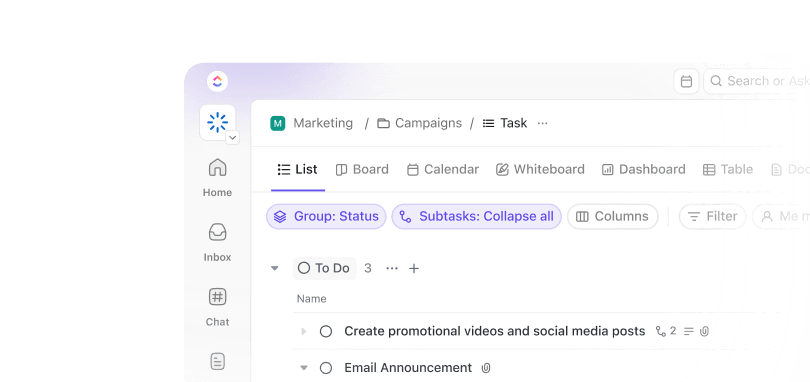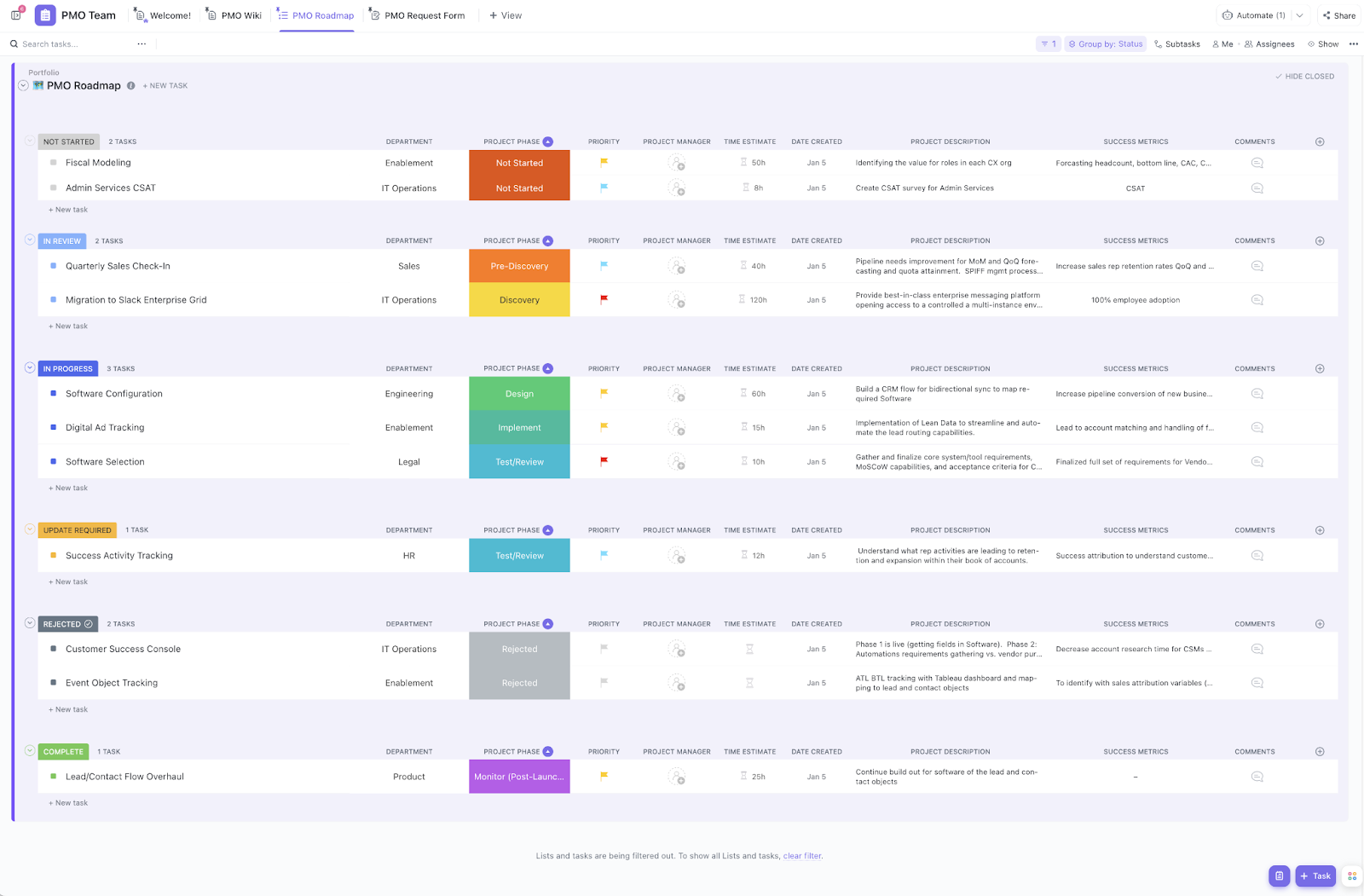With projects growing more complex, finding the right productivity tool can make or break your team’s success.
Two major players keep coming up in conversation: Notion and Asana. Both promise to transform how you work, but they approach productivity from different angles.
Notion combines flexibility with a powerful note-taking capability, allowing users to create custom dashboards, databases, and collaborative documents. Meanwhile, Asana excels in task management, providing teams with robust tracking, reporting, and integration features.
So, which one deserves your attention? Well, it depends on what you’re looking for.
In this blog, we’ll explore the strengths and weaknesses of Notion and Asana, helping you decide which productivity tool ultimately reigns supreme for your team’s needs.
⏰ 60-Second Summary
Here’s a quick summary of the key differences between Notion and Asana.
We’ve also included ClickUp, the everything app for work and the best alternative to Notion and Asana:
| Feature | Notion | Asana | ⭐️ Bonus: ClickUp |
| Workspace type | Flexible workspace for notes, planning, and tasks | Structured project management tool | Combines Notion’s flexibility with Asana’s automation |
| Project organization | Dashboards, kanban boards, nested pages | Tasks, subtasks, dependencies | Boards, timelines, whiteboards, dashboards |
| AI capabilities | Summarize, draft, automate admin tasks | AI summaries, smart suggestions, automation | ClickUp Brain converts chats/emails into tasks |
| Task management | Assign tasks, track progress | Assign, prioritize, and automate tasks | Automate updates, manage deadlines, redistribute workloads |
| Integrations | Slack, Google Drive, others | Slack, Salesforce, others | 1,000+ apps including Slack and Google Drive |
| Reporting | Manual dashboards | Built-in reports | Advanced dashboards, agile reporting |
| Collaboration | Basic commenting and page sharing | Real-time messaging, comments, file sharing | Chat, comments, real-time editing |
| Pricing* | Free plan; Paid starts at $12/user/month | Free plan; Paid starts at $13.49/user/month | Free Forever; Customizations available for enterprises |
What Is Notion?
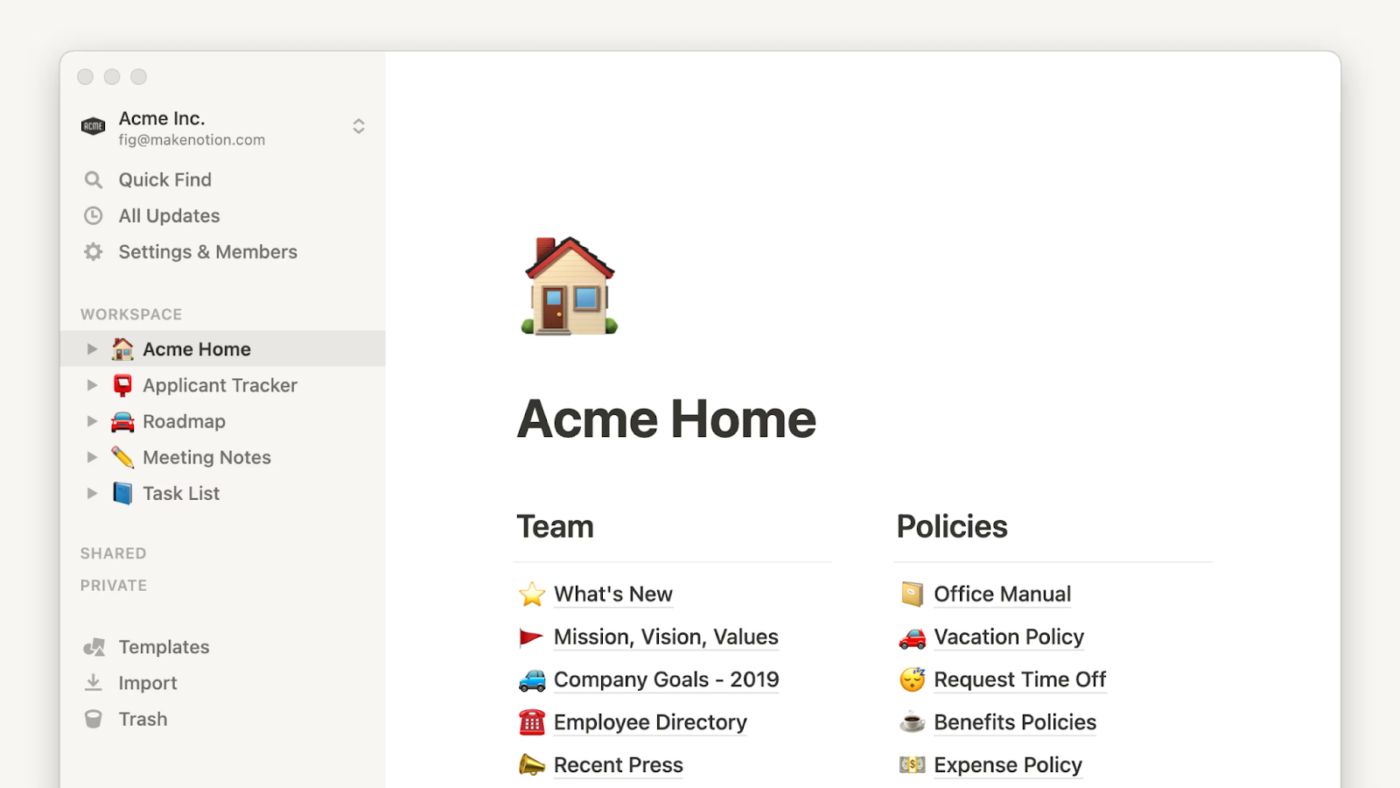
Notion is a workspace application that combines note-taking, project management, and knowledge base features. Whether you’re capturing ideas, managing projects, or running an entire company, Notion offers the flexibility to do it the way you want.
Notion users rely on the platform to:
- Store research materials, transcripts, and user interviews
- Extract insights using AI
- Organize and restructure information with nested pages
- Automate tasks like summaries and follow-up emails
Notion features
Here are some of the most useful features of Notion that stick out:
Feature #1: Customizable workspaces that actually work
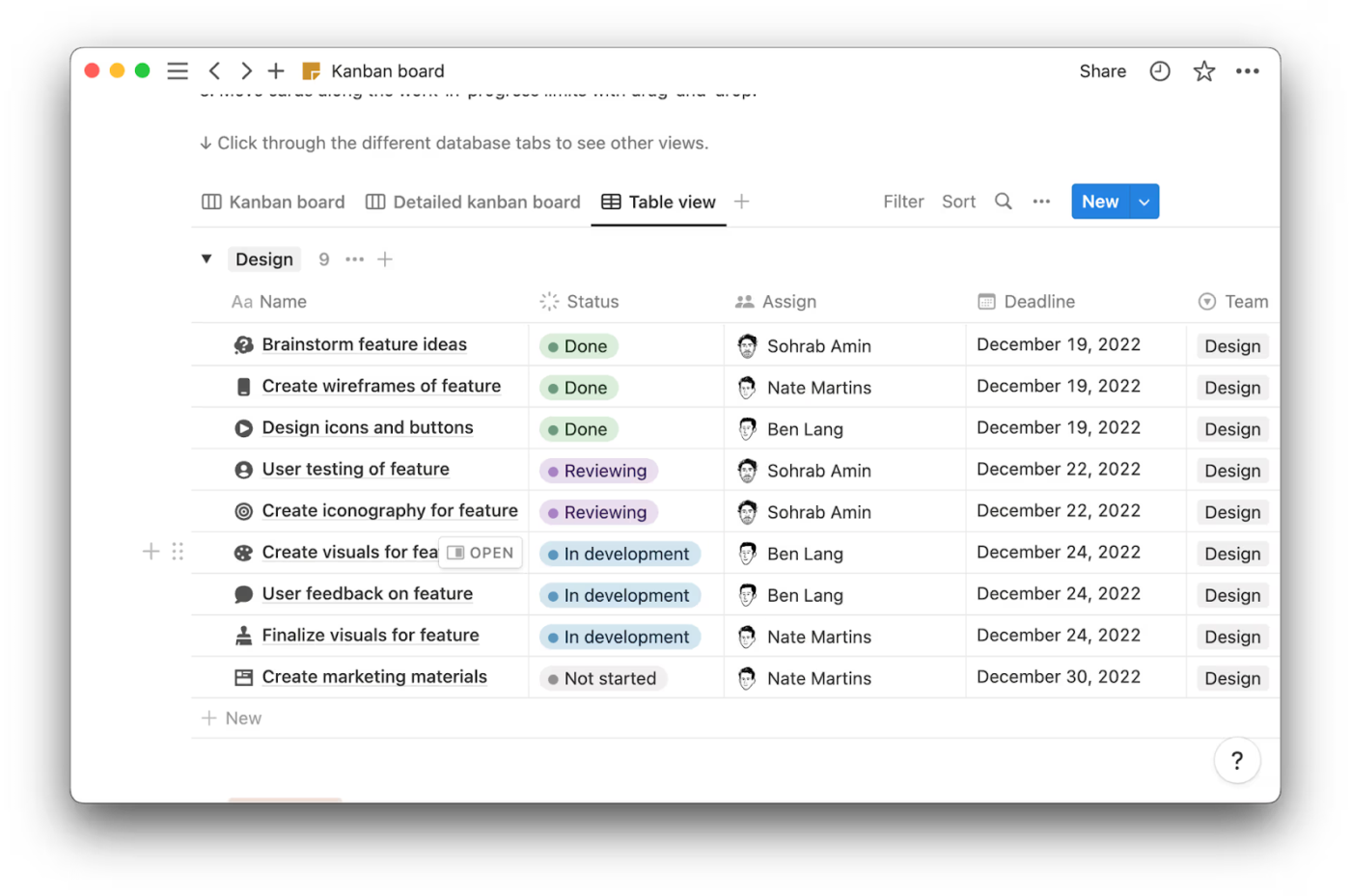
In a world of one-size-fits-all productivity tools, Notion is more like a build-your-own-project-management-platform. Users can create projects, manage tasks, and design their own dashboards with databases, kanban boards, and to-do lists.
💡 Pro Tip: AI can simplify your workflow, but not all AI tools are created equal. ClickUp AI vs. Notion AI: Which AI Tool is Best? Breaks down how each tool helps with task management, automation, and content creation—so you can find the best fit for your team.
Feature #2: A second brain for note-taking and knowledge management
If your brain is basically 72 open browser tabs, Notion offers a unified workspace where you can take notes, save research, and organize everything neatly. From UX designers storing research transcripts to writers planning entire novels, users love how easy it is to organize and retrieve information with nested pages and databases.
Feature #3: Notion AI: Notion’s built-in productivity assistant
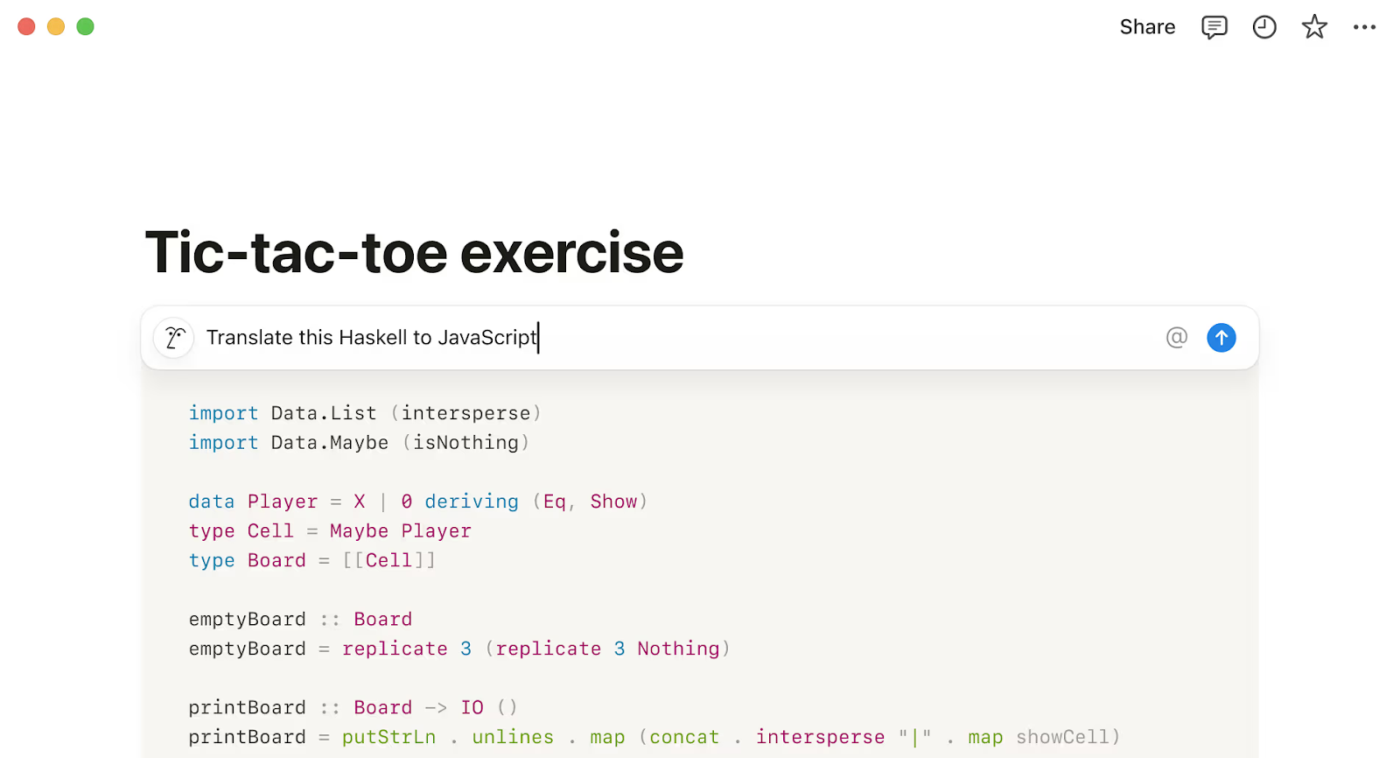
Summaries make our lives easier. Notion AI helps in this by summarizing documents, drafting content, generating reports, and automating follow-up emails. These tools are designed to support everyday writing and organizational tasks within a project workspace.
💡 Pro Tip: Notion AI can speed up your workflow, but are you using it to its full potential? How to Use Notion AI: Maximize Efficiency with Notion AI explores the best AI-powered features and top templates.
Feature #4: Seamless collaboration for multiple team members
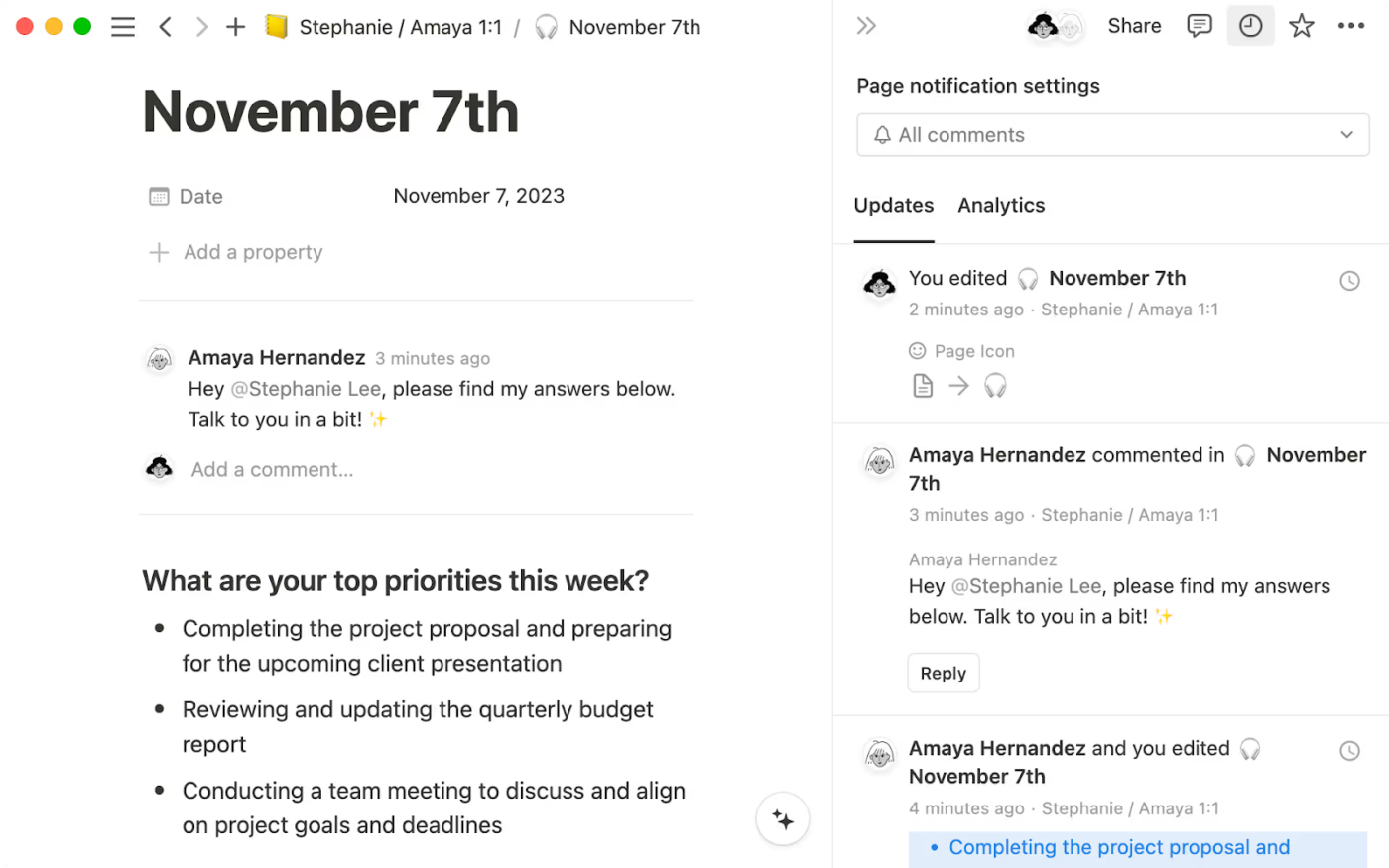
Notion is designed to collaborate. Teams can assign tasks, track project progress, and easily communicate all in one place. Whether you’re handling multiple projects or managing an entire company, Notion empowers you with real-time updates and shared templates.
Feature #5: Integration with other tools
It’s tough to work with a productivity tool that doesn’t play well with others. Notion integrates with Google Drive, Slack, and other productivity tools, ensuring your team doesn’t waste time switching between apps just to get work done.
💡 Pro Tip: While Notion is great for documentation, ClickUp goes beyond built-in tasks, automation, and real-time collaboration—all in one place. See why teams are making the switch in See Why Teams Choose ClickUp Over Notion.
Notion pricing*
Notion offers a range of pricing plans suited for individuals, small teams, and large enterprises. Here’s a breakdown:
- Free
- Plus: $12/month per user
- Business: $24/month per user
- Enterprise: Custom pricing
*Please check the tool’s website for the latest pricing
📮 ClickUp Insight: Practically your entire workforce is drowning in unnecessary information
92% of knowledge workers risk losing key decisions buried in scattered chats, overflowing inboxes, and endless spreadsheets. Without a centralized system to capture and track these decisions, valuable business insights disappear into the digital void. ClickUp’s Task Management ensures that never happens—instantly turn chats, comments, docs, and emails into actionable tasks with just one click.
What Is Asana?
Asana is a project management platform that helps teams organize, track, and manage their work, projects, and tasks.
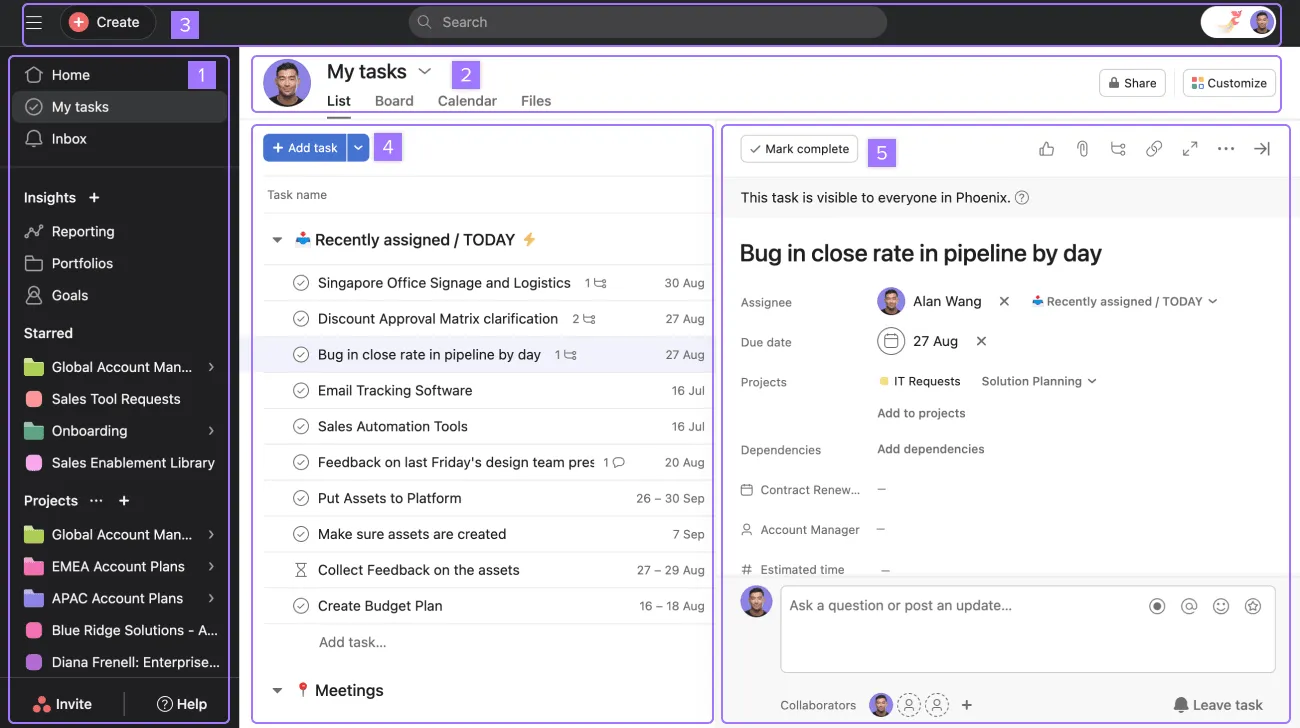
Asan’as core brand values manifest in the following features Asana offers:
- Assign tasks, set deadlines, and track progress across teams
- Break down complex projects into tasks and subtasks
- Organize work using priority levels, due dates, and collaboration tools
- Use built-in calendar and notifications to stay on schedule
- Integrate with apps like Salesforce and Slack
💡 Pro Tip: Managing complex projects in Asana can feel restrictive with its limited task management features. 20 No-Brainer Reasons To Choose ClickUp Over Asana breaks down how ClickUp gives your team the flexibility, automation, and collaboration tools needed to execute projects seamlessly.
Asana features
Here’s an overview of Asana’s most popular (and useful) features:
Feature #1: Task management that keeps everything (and everyone) on track
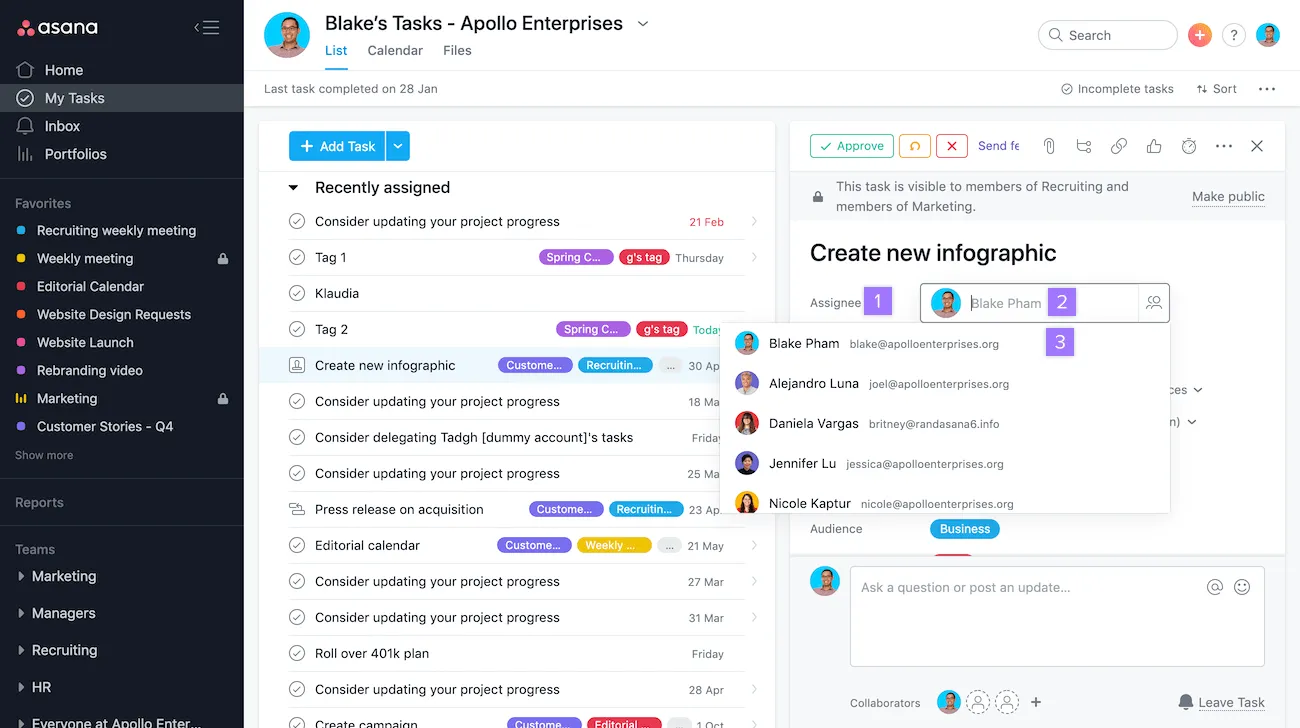
Asana offers a task management system that allows teams to assign tasks, set priorities, and track progress—all in one place. Unlike some traditional project management tools, tasks in Asana can live in multiple projects, so different teams can collaborate without duplicating work.
Feature #2: Workflow automation that saves you time
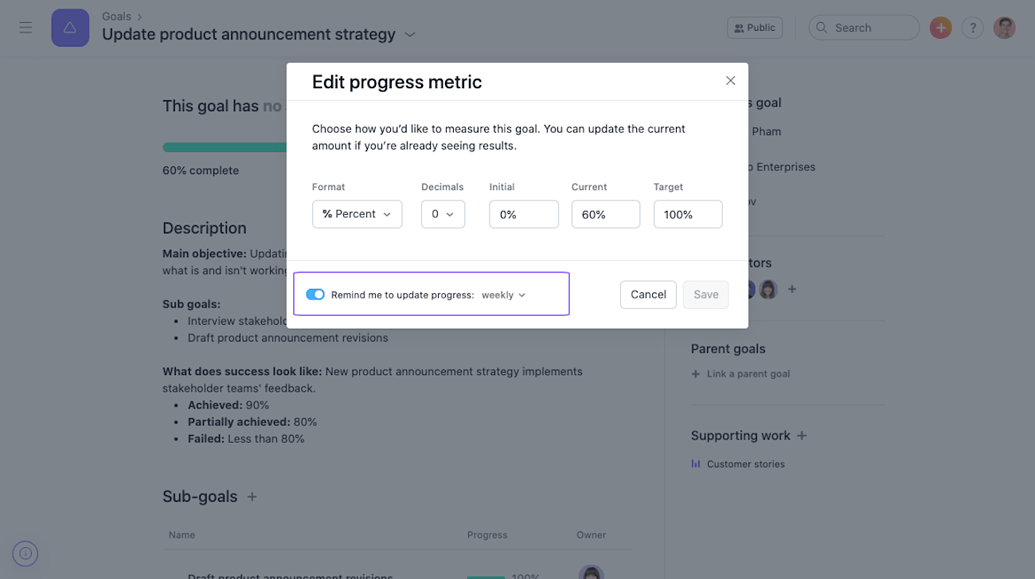
With Asana’s automation features, teams can set up rules and triggers that automatically move tasks, assign teammates, and send reminders.
Feature #3: Multiple project views for ultimate flexibility
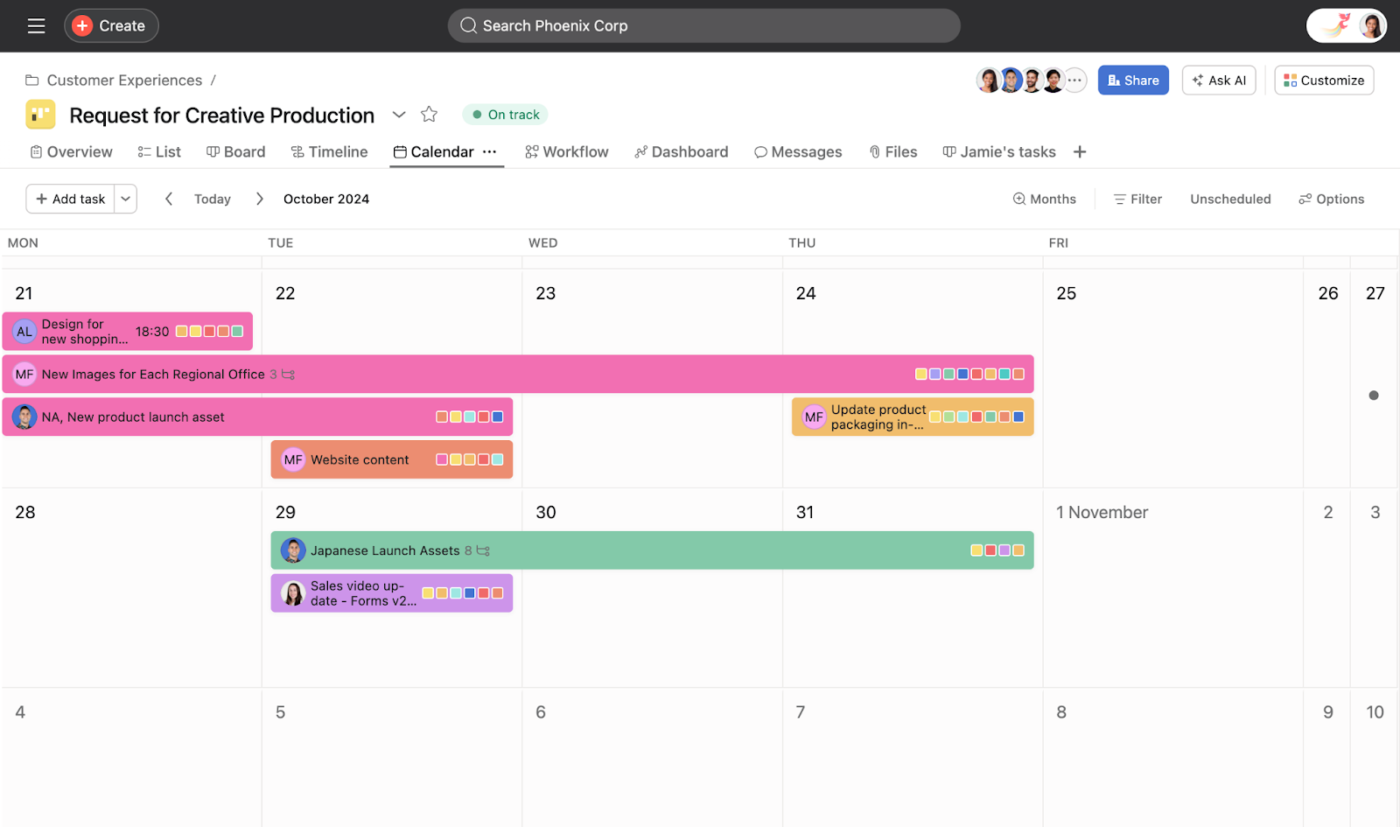
Asana offers multiple ways to view project data, including list view, kanban boards, calendar view, and Gantt-style timelines. Whether you’re a visual planner or a structured list lover, Asana lets you track projects in the way that works best for you.
💡 Pro Tip: Asana is great for simple task management, but if your team needs built-in chat, multi-user task assignments, or CRM capabilities, it might be holding you back. Top 15 Asana Alternatives and Competitors explores the best tools that offer more flexibility, automation, and scalability for growing teams.
Feature #4: Seamless team collaboration
Asana offers a collaborative workspace where team members can comment on tasks, attach files, and tag teammates in real time. Users love that they can email tasks directly to Asana and integrate them with tools like Google Drive, Slack, and Salesforce, making it a true all-in-one workspace.
Feature #5: Customizable dashboards and reporting
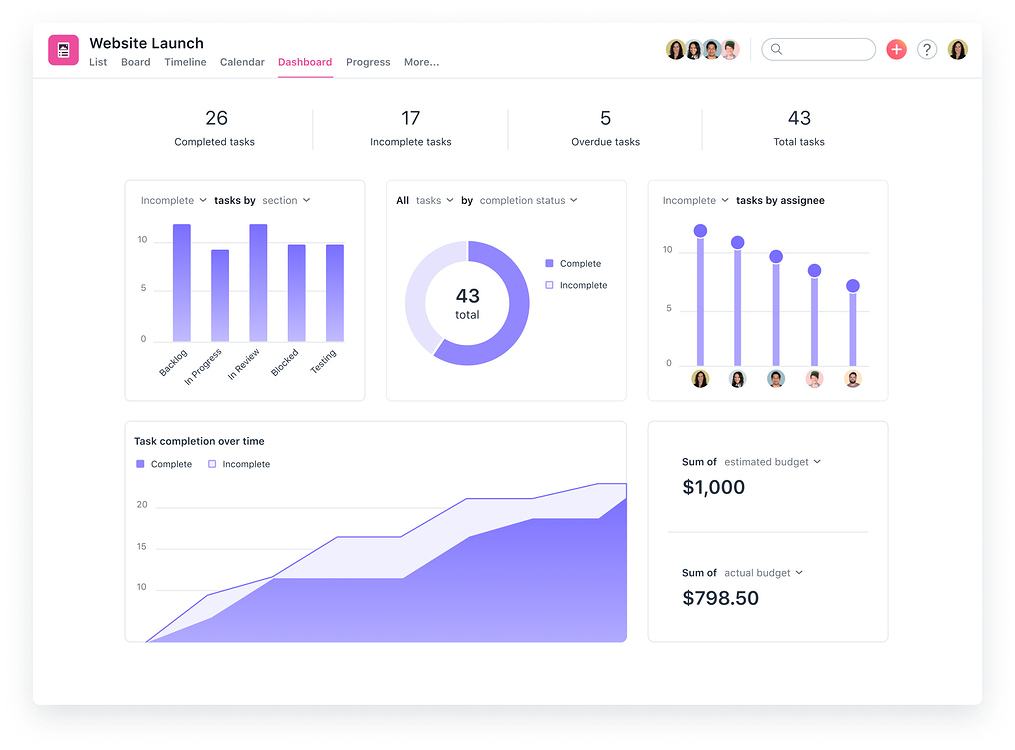
Need to know how your project’s progress is shaping up? Asana offers customizable dashboards and advanced reporting tools to track key project management metrics. This helps project managers get a clear picture of task dependencies, upcoming deadlines, and workload distribution—so nothing catches the team off guard.
💡 Pro Tip: In How Teams Channel Their Productivity With ClickUp, see how real teams cut through the chaos, automate the busywork and stay focused on what truly matters.
Asana pricing*
Asana offers multiple pricing plans for individuals, small teams, and large enterprises. Here are all the tiers:
- Personal: Free
- Starter: $13.49/month per user
- Advanced: $30.49/month per user
- Enterprise: Custom pricing
*Please check the tool’s website for the latest pricing
💡 Pro Tip: Asana limits key project management features behind paywalls, while ClickUp offers more tools—free, forever. From custom task statuses to built-in Docs and Automations, see why teams choose ClickUp as the flexible alternative to Asana.
Notion vs. Asana: Features Compared
Both Notion and Asana offer powerful productivity and robust project management features, but they approach organization and collaboration differently.
Let’s break down the key features and see which tool comes out on top.
Feature #1: Project and task management
Asana excels in structured task management with Kanban boards, lists, and timeline views, making it easy to assign tasks, set dependencies, and track progress.
Notion, on the other hand, offers customizable workspaces with embedded databases that can function as to-do lists, task boards, and knowledge hubs. However, it lacks Asana’s built-in automation for task dependencies and reminders.
🏆 Winner: Asana
Feature #2: Collaboration and team communication
Notion allows teams to collaborate in real time on documents, wikis, and databases. You can tag team members, leave comments, and integrate shared templates.
Asana takes collaboration up a notch with built-in messaging, video recording, task comments, and real-time notifications. Teams can also automate updates, ensuring everyone stays in sync without extra manual effort.
🏆 Winner: Asana
Feature #3: Customization and flexibility
Notion is unmatched in flexibility—users can create custom dashboards, embed spreadsheets, and design unique workflows tailored to their needs. You can structure your entire work environment the way you like.
Unlike Notion, Asana is more rigid and has a steeper learning curve that comes with structured project templates, automation, and reporting tools, making it easier to scale without as much manual setup.
🏆 Winner: Notion
💡 Pro Tip: Stop reinventing the wheel with every new project! 30 Free Project Management Templates for All Types of Projects gives you ready-to-use, customizable templates that simplify workflows and keep your team on track.
Feature #4: Automation and AI capabilities
Notion AI is more focused on content creation than workflow automation. It excels at summarizing notes, generating ideas, and organizing information but lacks the same level of workflow automation that Asana offers.
🏆 Winner: It’s a tie!
Feature #5: Reporting and analytics
Asana offers powerful automation tools, allowing users to set recurring tasks, dependencies, custom workflows, and rule-based triggers. It also includes Asana Intelligence (AI-powered insights), which can suggest smarter goals, summarize tasks, and provide project recommendations.
Asana provides advanced reporting tools like custom dashboards, real-time progress tracking, workload management, and timeline reports. Teams can visualize bottlenecks and adjust workloads based on insights.
Notion lacks built-in reporting tools, but users can create custom dashboards with linked databases, progress trackers, and charts. However, setting up analytics in Notion requires manual configuration, unlike Asana’s ready-to-use reporting system.
🏆 Winner: Asana
Also Read: 15+ Free Asana Project Management Templates
Notion vs. Asana on Reddit
When comparing Notion and Asana, user feedback from Reddit provides valuable insight into how people actually use, love, or struggle with these tools.
First of all, users love Notion’s flexibility and ability to integrate multiple workspaces into one system. As one user pointed out:
However, there are reviews where users share feeling overwhelmed by Notion’s endless customization and spend more time setting up their system than actually completing tasks.
Meanwhile, Asana users, especially those who need a structured to-do list with strong mobile functionality, really appreciate its personal task management.
But, just like Notion, there are Asana critics as well, who are frustrated with the tool’s complexity, lack of clear best practices, and limited customer support.
Also Reddit: Best Notion AI Alternatives and Competitors
Meet ClickUp — The Best Alternative to Notion vs. Asana
Notion and Asana are productivity tools that have won over thousands of users.
However, they each have gaps:
📌 Notion is excellent for brain dumping, AI-powered content generation, structured pages, and customized productivity dashboards. However, it lacks advanced automation and team workload tracking.
📌 Asana is great for workflow automation. It helps managers see who’s overloaded with work, redistributes tasks and tracks them, and offers deep integrations with enterprise tools like Salesforce, Tableau, and Power BI. However, it lacks the flexibility and customization Notion offers.
These missing features create gaps in productivity, but ClickUp—the Everything app for work—bridges them perfectly!
And Reddit users seem to agree:
With ClickUp, you get productivity, project management, and collaboration tools all built into one platform. Let’s quickly understand what you can get done with ClickUp.
💡 Pro Tip: Constantly switching between apps kills productivity and focus. What Benefits Make ClickUp Unique breaks down how an all-in-one work hub eliminates distractions.
ClickUp’s One Up #1: AI-powered project management
You’re leading a product launch with multiple teams, deadlines, and dependencies. Normally, project management teams spend hours coordinating tasks, tracking progress, and sending updates.
With ClickUp Tasks, this all happens automatically.
✅ The system analyzes team workloads and redistributes tasks—no one gets overloaded
✅ AI detects delays or bottlenecks and adjusts deadlines dynamically to keep things on track
✅ Status updates? ClickUp writes them for you based on real-time project data
✅ Visualizes timelines, tracks dependencies, and adjusts deadlines in real time
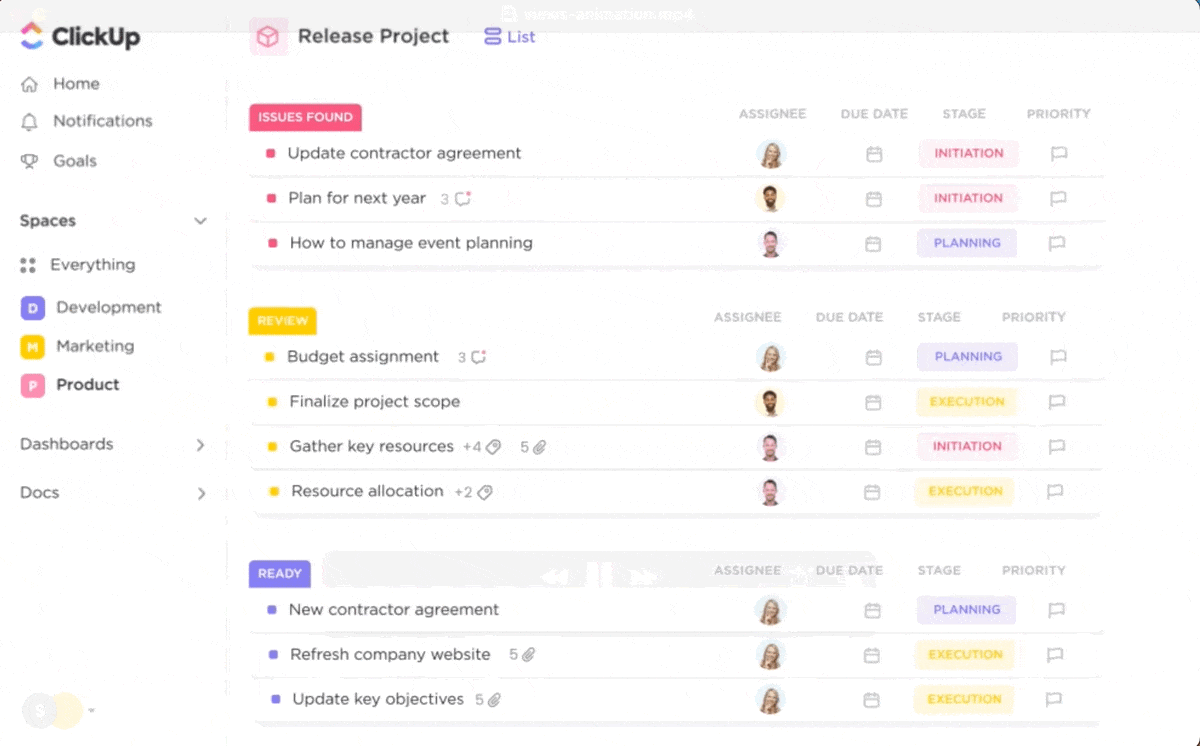
With built-in automations—repetitive tasks like assigning team members, updating statuses, or triggering notifications can run without lifting a finger. Even better? You can turn form submissions into tasks instantly.
To prevent burnout, ClickUp’s Workload View balances assignments across your team, while ClickUp Dashboards offer real-time insights into KPIs, budget health, and delivery timelines.
In fact, ClickUp’s Project Management Template lets you experience the mentioned features with zero prep and training.
Keeping large, cross-functional projects on track is challenging when teams are scattered across different tools and communication breaks down. Understanding the challenge, this template centralizes unlimited tasks, timelines, and collaboration in one place.
With clear workflows and automated tracking—teams stay aligned, and it becomes impossible to miss deadlines.
ClickUp’s One Up #2: AI-powered docs that execute
Notion is good for documentation—but static pages don’t move projects forward. Ideally, they should connect to work and automate execution.
ClickUp Docs is intelligent, action-driven, and deeply integrated into your workflow.
✅ Create structured docs, wikis, and SOPs in seconds
✅ Highlight any text and instantly convert it into an assignable, trackable task
✅ Edit together, leave comments, and get AI-generated summaries of discussions
✅ Link project plans directly to tasks, automations, and dashboards
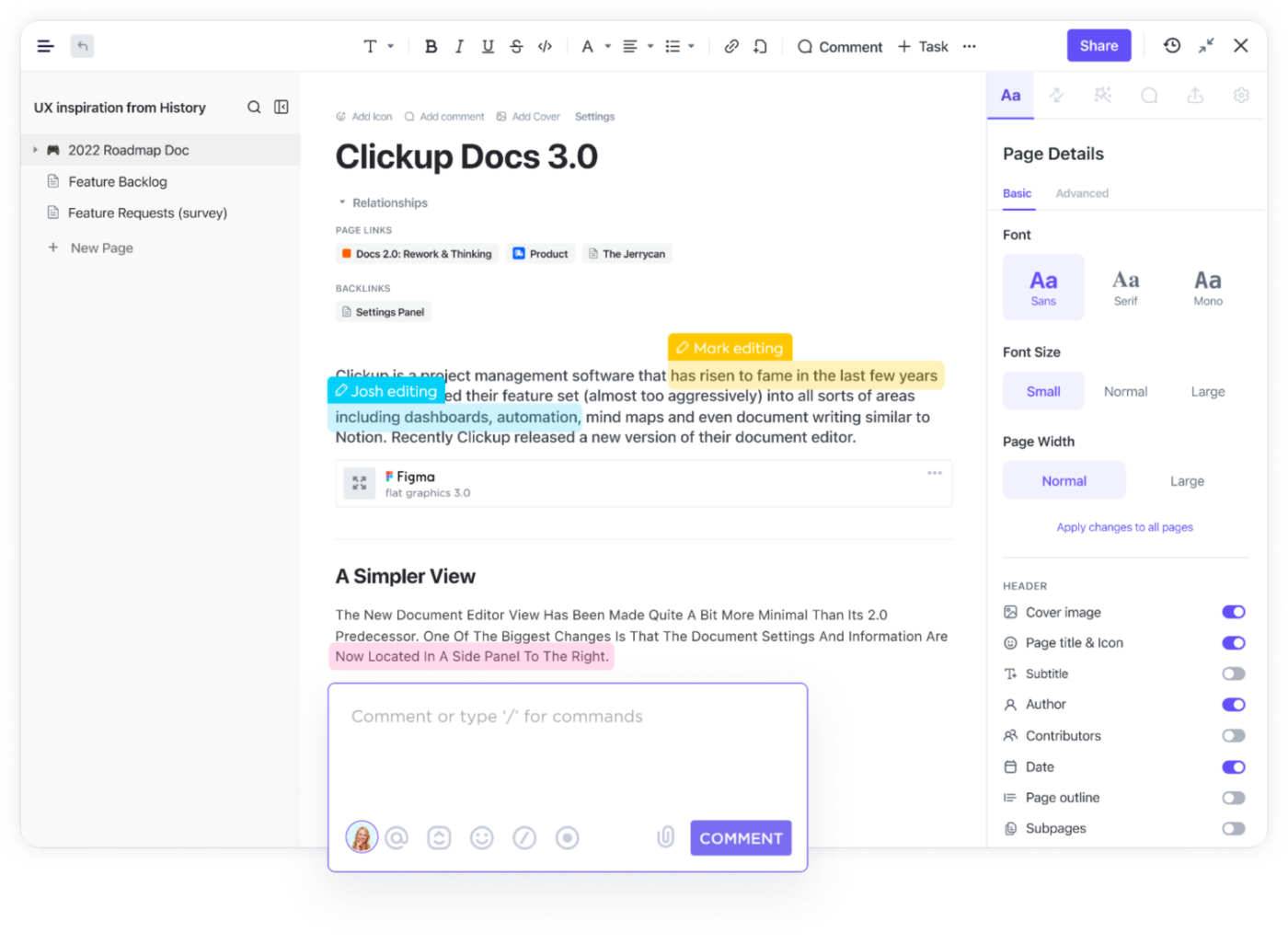
These are only the basic functions— ClickUp Docs goes even further.
Use templates, nested pages, and rich formatting with /Slash commands to quickly build anything from a roadmap to a customer playbook. Use drag-and-drop tables, embed bookmarks, drop in charts, and create buttons to guide users through interactive content. And with Focus Mode, distraction-free writing becomes effortless.
Everything in ClickUp Docs is searchable, secure, and easy to share—whether you’re working privately, with a team, or with external clients. And thanks to the Docs Hub, your entire library of pages, templates, and resources stays organized and instantly accessible.
However, if you’re a project manager looking to get started right away, you can explore ClickUp’s Project Management Schedule Template—it simplifies planning by providing a clear timeline, structured task lists, and real-time tracking to keep projects organized and on schedule.
ClickUp’s One Up #3: ClickUp’s AI capabilities
We have already discussed AI a bit, but let’s go deeper to understand its use cases and impact. Other AI tools usually just generate content. ClickUp Brain takes it further—it turns content into action.
Let’s say your marketing team is crafting a new campaign strategy.
In Notion, you’d type ideas into a doc.
In Asana, you’d manually create tasks.
In ClickUp? You write once, and AI does the rest.
✅ ClickUp instantly generates a campaign outline with objectives, timelines, and key deliverables
✅ AI converts strategy points into action items, assigning them to the right team members
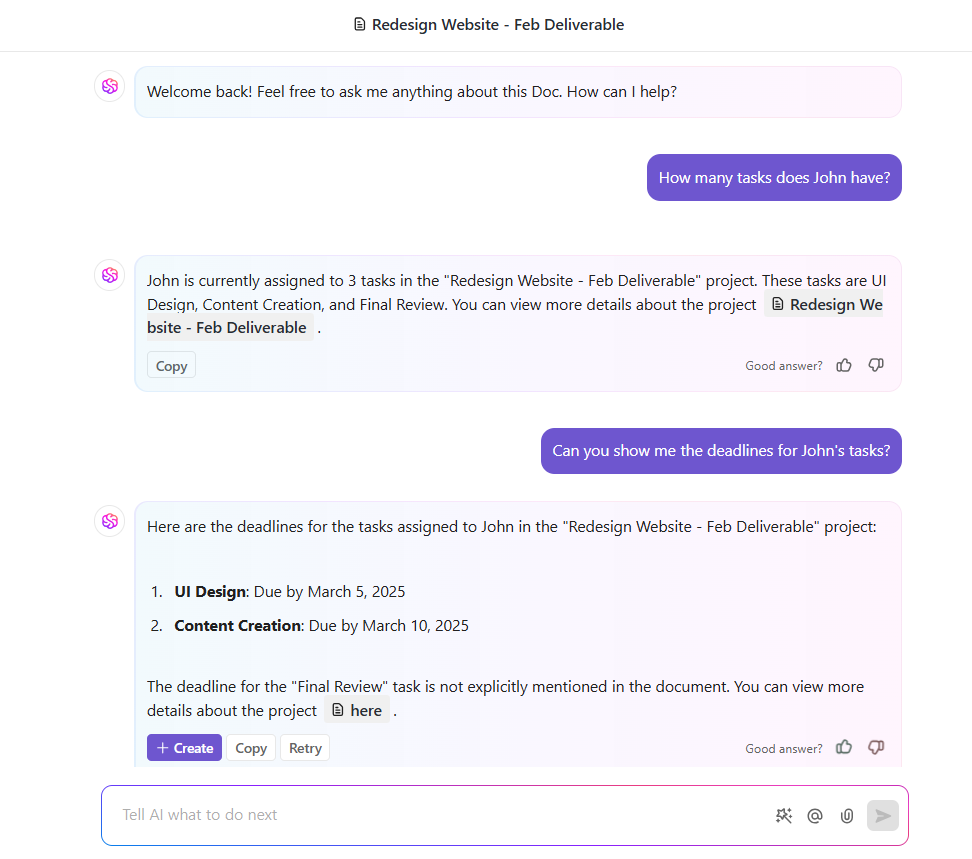
You will truly feel ClickUp Brain’s impact once you see it in action. First of all, you get more than just smart suggestions. You get a neural network that understands your workspace.
Ask questions like “What’s the latest on the Q3 ad campaign?” or “Who’s responsible for the SEO audit?”—and get instant, contextual answers.
Additionally, ClickUp Brain transforms the way teams interact with their work with capabilities like voice-to-text transcription, automatic time-blocking, and an integrated writing assistant that checks spelling and tone.
Also Read: Best AI Collaboration Tools to Use
Why Manage Tasks in Two Apps When ClickUp Does It in One?
Managing projects across multiple apps is a productivity killer. ClickUp users know the struggle all too well, and that’s exactly why they made the switch. Andrea Park, Business Operations Coordinator at Spekit, puts it best:
Instead of hopping between Notion for notes, Asana for tasks, and other apps for reporting, use ClickUp, a dedicated project management tool that brings everything under one roof. With over 15+ work views, built-in AI automation, and deep integrations, it simplifies task management, goal tracking, team collaboration, and reporting.
Create an account for free and connect your people, content, and tools in one intelligent system with ClickUp.

